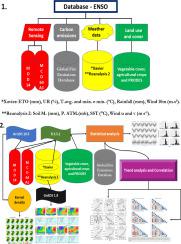当前位置:
X-MOL 学术
›
Agric. For. Meteorol.
›
论文详情
Our official English website, www.x-mol.net, welcomes your
feedback! (Note: you will need to create a separate account there.)
Fire regime in Southern Brazil driven by atmospheric variation and vegetation cover
Agricultural and Forest Meteorology ( IF 5.6 ) Pub Date : 2020-12-01 , DOI: 10.1016/j.agrformet.2020.108194 Caio F. de Andrade , Rafael C. Delgado , Maria Lucia F. Barbosa , Paulo E. Teodoro , Carlos A. da Silva Junior , Henderson S. Wanderley , Guilherme F. Capristo-Silva
Agricultural and Forest Meteorology ( IF 5.6 ) Pub Date : 2020-12-01 , DOI: 10.1016/j.agrformet.2020.108194 Caio F. de Andrade , Rafael C. Delgado , Maria Lucia F. Barbosa , Paulo E. Teodoro , Carlos A. da Silva Junior , Henderson S. Wanderley , Guilherme F. Capristo-Silva

|
Abstract The use of uncontrolled fire by human beings associated with climate conditions favorable to burning has caused social, economic and environmental damage in different parts of the world. The objective of the present study was to evaluate the variations in the occurrence of fire in Southern Region of Brazil caused by the seasonal characteristics of the years. We also sought to highlight the vegetation coverings most affected by fires within each year assessed and among the different ENSO events. Fire products from the MODIS were associated with meteorological elements and vegetation cover data, in addition to evaluating Carbon emission data made available by GFED. The correlation between the meteorological elements and fire was obtained by Spearman's non-parametric approach. Additionally, Mann Kendall's statistical test was performed with the harvested area extensions of three temporary agricultural crops (Maize, Soybean and Sugarcane) over 28 years. Fire in Southern Brazil correlates mainly with reduced rainfall and relative air humidity together with increased atmospheric pressure and increased wind speed. The periods under the effect of the cold phase of the phenomenon (La Nina) presented 26% to 114% more fire foci than those under the hot phase (El Nino). La Ninas also showed 7% to 77% more burned area than El Ninos. La Nina events emitted more carbon into the atmosphere than El Nino, and the greatest difference was observed between La Nina 2007/2008 (1.51 Tg) and El Nino 2015 (0.65 Tg). The vegetation covers most affected by the fire were those related to agricultural activity. Mann Kendall's statistics indicated that Sugarcane, an agricultural crop with flammable straw, showed a tendency to expand in the state of Parana between 1990 and 2018. Intra and inter-annual atmospheric variations and the mosaic of different vegetation covers determined the fire pattern in the study area over the period studied.
中文翻译:

由大气变化和植被覆盖驱动的巴西南部火灾状况
摘要 人类使用与有利于燃烧的气候条件相关的不受控制的火已经在世界不同地区造成了社会、经济和环境破坏。本研究的目的是评估巴西南部地区由于年份的季节性特征引起的火灾发生的变化。我们还试图在评估的每一年和不同的 ENSO 事件中突出受火灾影响最严重的植被覆盖。除了评估 GFED 提供的碳排放数据外,MODIS 的火灾产品还与气象元素和植被覆盖数据相关联。气象要素与火灾的相关性是通过斯皮尔曼的非参数方法获得的。此外,曼肯德尔 s 统计检验是在 28 年间对三种临时农作物(玉米、大豆和甘蔗)的收获面积扩展进行的。巴西南部的火灾主要与降雨量和相对空气湿度减少以及大气压力增加和风速增加有关。受该现象冷期(拉尼娜)影响的时期比热期(厄尔尼诺)多出 26% 至 114% 的火源。拉尼娜现象的燃烧面积也比厄尔尼诺现象多 7% 到 77%。拉尼娜事件向大气排放的碳比厄尔尼诺事件多,拉尼娜事件 2007/2008 (1.51 Tg) 和厄尔尼诺事件 2015 (0.65 Tg) 之间的差异最大。受火灾影响最大的植被是与农业活动有关的植被。曼肯德尔的统计数据表明,甘蔗、
更新日期:2020-12-01
中文翻译:

由大气变化和植被覆盖驱动的巴西南部火灾状况
摘要 人类使用与有利于燃烧的气候条件相关的不受控制的火已经在世界不同地区造成了社会、经济和环境破坏。本研究的目的是评估巴西南部地区由于年份的季节性特征引起的火灾发生的变化。我们还试图在评估的每一年和不同的 ENSO 事件中突出受火灾影响最严重的植被覆盖。除了评估 GFED 提供的碳排放数据外,MODIS 的火灾产品还与气象元素和植被覆盖数据相关联。气象要素与火灾的相关性是通过斯皮尔曼的非参数方法获得的。此外,曼肯德尔 s 统计检验是在 28 年间对三种临时农作物(玉米、大豆和甘蔗)的收获面积扩展进行的。巴西南部的火灾主要与降雨量和相对空气湿度减少以及大气压力增加和风速增加有关。受该现象冷期(拉尼娜)影响的时期比热期(厄尔尼诺)多出 26% 至 114% 的火源。拉尼娜现象的燃烧面积也比厄尔尼诺现象多 7% 到 77%。拉尼娜事件向大气排放的碳比厄尔尼诺事件多,拉尼娜事件 2007/2008 (1.51 Tg) 和厄尔尼诺事件 2015 (0.65 Tg) 之间的差异最大。受火灾影响最大的植被是与农业活动有关的植被。曼肯德尔的统计数据表明,甘蔗、











































 京公网安备 11010802027423号
京公网安备 11010802027423号